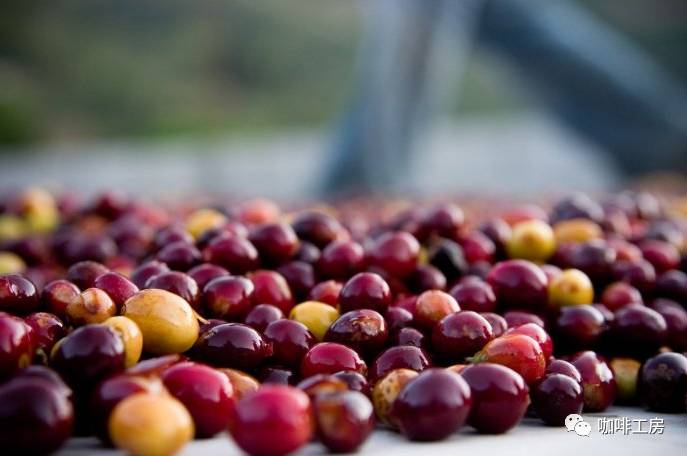Introduction to the subclassification of common coffee varieties in cafes

For professional baristas, please follow the coffee workshop (Wechat official account cafe_style)
Coffee beans are divided into three original species systems.
Arabica coffee beans, also known as Arabica coffee beans
Robusta coffee beans, also known as Congo coffee beans.
Libyan coffee beans, also known as Liberian coffee beans
There are more than 100 kinds of coffee in the world today.
Common cultivated species, multi-genus, three original species system and some hybrids
The three original species can be subdivided into dozens of varieties.
Therefore, coffee beans will have different characteristics according to different varieties, producing areas and brands.
Arabica coffee beans account for 76% of the world's total output.
Robusta coffee beans, accounting for about 20% of the world's total output.
Liberian coffee beans are consumed only by people in Europe, except in a few producing countries.
Arabica coffee was first introduced in Taiwan. At present, Arabica coffee is also cultivated in a large area.
"Coffee varieties" have recently been concerned by coffee users, roasters or players, but most of them are not in-depth and persistent, because the industry is concerned about price and sales channels, and players focus on the improvement of baking skills. Will face up to the "coffee varieties" are mostly agronomists, botanists, coffee farmers and coffee lovers who like fine coffee (Specialty Coffee). With the improvement of Chinese people's culture of fine coffee in recent years, the number of their own roasters is increasing day by day, coffee trade is no longer the business of large-market merchants, and there is a gradual emergence of minority funds to buy raw beans directly from the origin or to participate in international bidding activities for raw beans. Coffee varieties are also gradually concerned by buyers.
Coffee belongs to the evergreen shrub of the genus Rubiaceae. There are about 40 species of plants under the branch of the genus Coffee, among which there are only three species of coffee of commercial value-Coffea Arabica, Coffea Robusta [Note 1] Coffea Liberica, these three varieties are called "the three native species of coffee". Arabica species account for about 70% of the world's total production, accounting for about 80% of the world's total demand for boutique coffee; 20% of Robusta species are mainly used for instant and canned coffee, and the caffeine content is twice that of Elaraby species; Liberian species are not resistant to leaf rust and have a poor flavor, they are only traded in Suriname, Libya, C ô te d'Ivoire and other countries in West Africa, and are not popular all over the world.
Coffee suffers from many challenges in the growth process, such as moisture, frost, diseases and insect pests. Among them, "leaf rust" is the most harmful. Natural things evolve under natural selection, and so do coffee trees, so the "Tibica species" and "bourbon species" mentioned in this paper belong to the "species" of biological taxonomy, phylum, class, order, family, genus, and species. Downward classification can be divided into "subspecies", "varieties" and "varieties", among which there are mutant varieties that appear in natural evolution, while others are deliberately bred into varieties with special needs. Generally speaking, the Arabica species that are often seen on the market are only a general statement, and the actual species are not subdivided, only that their ancestors are Arabica species.
The following describes the varieties evolved from the Arabica species
[Typica] iron card species
It is closest to the native species. The bean shape is slightly like an elongated egg and is called Arabigo or criollo in Central America. It has a sour taste of clean lemon, sweet aftertaste, low resistance to leaf rust, low seed setting and long harvest period (once every two years).
[Bourbon] bourbon species
The second species mutated by Typica is the closest to the original species as Typica. It was found in Reunion (formerly Bourbon) near Madagascar. Some coffee experts think that Bourbon is just a natural variant of Typica, nothing special! But in fact, Bourbon has its own characteristics, like Typica has the sour taste of red wine, sweet aftertaste, from the coffee leaves and beans to distinguish between Typica and Bourbon,Bourbon leaves are wider, fruity coffee cherries are smaller, the formation is more dense, so the bean appearance is smaller and more round than Typica. In Kenya and Tanzania, new artificial varieties "SL28" and "SL34" appeared when Bourbon was used for artificial mixing, which is famous for its excellent flavor. Although the seed setting amount of Bourbon is higher than that of Typica, the harvest time is 2 years, so it can be regarded as a variety with low yield.
[Caturra] Kaddura species
Mutant of Bourbon. It was first found in Brazil and began to be planted for commercial use in Minas Gerais, Brazil in 1937. The taste is sour with lemon or citrus taste, but not as sweet as Typica and Bourbon in sweetness, because the sweetness of Caturra depends on the number and dosage of fertilizer applied by the grower, so it has high production capacity, but it must be continuously fertilized and pruned to maintain production capacity, so the trees are short and branched. Although the production capacity has increased, the production is still limited because of the two-year harvest period and the high cost of care.
[Mundo Novo] Mondonovo species
Typica and Bourbon were mixed. The height of the tree is more than three meters, which makes it difficult to harvest. There is a lack of sweetness on the palate and bitterness in the back. The advantage is that it has high production capacity and is a high-yield variety.
[Catuai] Katuai seed
In the mating of Caturra and Mundo novo, the tree of Caturra is short and the height of Mundo novo is higher, so it is more convenient to harvest after improving the height of the hybrid. The taste is ordinary, the sweetness performance is similar to that of Cattura, and the fertilization technology is closely related. Planting density is high, proper fertilization can have high production capacity, trees are resistant to wind and rain, and the harvest period is only 1 year, but the disadvantage is that the life span is only 10 years.
[Maragogype] Malaghipo species
Typica variants. In a place called Maragogype in Bahia in Brazil, bean granules are known as beans. Mild taste with slightly sour and sweet, shallow baking is recommended, because deep baking can not show characteristics. The output is very small.
[Pacamara] Parkmara species
Maragogype interbred with Pacas and is the brother of Maragogype.
[Pacas] Parks species
Caturra and Bourbon were mixed.
[Catimor] Cartimo species
[note 2] Timor and Caturra were mixed. Was found in Portugal in 1959. The palate is obvious and easy to distinguish, with a bit of acerbity and a salty finish. It is a high yield variety with high planting density and strong resistance to leaf rust.
[Geisha] geisha species
Geisha is a unique kind of Panamanian coffee, in recent years in boutique coffee shine brilliantly, ask the market in just a few years there is a "boutique queen" said, is the jewel of Panamanian coffee, the current output is low and the price is high, coffee farmers said in recent years discovered but this is not the case, Geisha not only appeared in Panama as early as 1960, in 1931, in southwestern Ethiopia was found, there are many different local names, such as Gesha. In 1931 and 1932, it was imported to Kenya under the name of Abyssinian and Geisha respectively. In 1936, Kenya took the harvested Geisha seeds to Uganda and Tanzania for planting. In July 1953, Tanzania sent the seed tree to Costa Rica, leaving the mother tree in its own country. In 1960, Geisha was formally cultivated through CATIE Panama. Geisha has a good aroma, sweet and clean finish, distinctive, fruity, with bright sour fruit flavors, such as mango and papaya, which is very supple and can be compared with Ethiopian water-washed beans.
[note 1] Coffea Robusta is in fact a mutant of Coffea Canephora.
[note 2] Timor is a mating species of Arabica and Robsta, and has strong resistance to leaf rust.
[note 3] CATIE-Tropical Agronomic Center for Research and Education
Subclassification of Arabica varieties.
In the world of "boutique coffee", only delicious Arabica varieties are classified and discussed.
The more representative varieties are:
Ancient native species: Heirloom (ancestral superior variety), Typica (Tibica), Bourbon (bourbon)
Typica variants: Maragogype (Giant Elephant Bean), Geisha (nicknamed geisha bean … Because of the homonym with [geisha], etc.
Well-known Bourbon variants: Caturra (Kaddura), Pacas (Pacas), etc.
Well-known hybrids: for example, Pacamara (Pacas + Giant Elephant Bean = Pacamara)
Important Notice :
前街咖啡 FrontStreet Coffee has moved to new addredd:
FrontStreet Coffee Address: 315,Donghua East Road,GuangZhou
Tel:020 38364473
- Prev

Five factors affecting the growing period and the best flavor period of coffee beans
Communication of professional baristas Please pay attention to coffee workshop (Wechat official account cafe_style) coffee beans are not in the best brewing condition after being roasted. It needs to be placed for a period of time to let the taste and flavor become ripe. This arrangement waits for the mature stage. As we commonly call the coffee beans cultivated or ripe, the taste and flavor of the coffee beans are fuller, the aroma is more complete and the exhaust is prosperous.
- Next

Analysis of brewing condition | Coffee extraction temperature is determined by the thickness of grinding and the amount of powder.
Professional baristas exchange please pay attention to the coffee workshop (Wechat official account cafe_style) extraction water temperature shallow roasting with high temperature, deep roasting with low temperature shallow roasting with low temperature, deep roasting with high temperature with bitter, low temperature with sour temperature will affect the dissolution rate of coffee ingredients, high temperature extraction, better aroma, better extraction taste, temperature also affects the expansion of coffee powder.
Related
- Beginners will see the "Coffee pull flower" guide!
- What is the difference between ice blog purified milk and ordinary milk coffee?
- Why is the Philippines the largest producer of crops in Liberia?
- For coffee extraction, should the fine powder be retained?
- How does extracted espresso fill pressed powder? How much strength does it take to press the powder?
- How to make jasmine cold extract coffee? Is the jasmine + latte good?
- Will this little toy really make the coffee taste better? How does Lily Drip affect coffee extraction?
- Will the action of slapping the filter cup also affect coffee extraction?
- What's the difference between powder-to-water ratio and powder-to-liquid ratio?
- What is the Ethiopian local species? What does it have to do with Heirloom native species?

